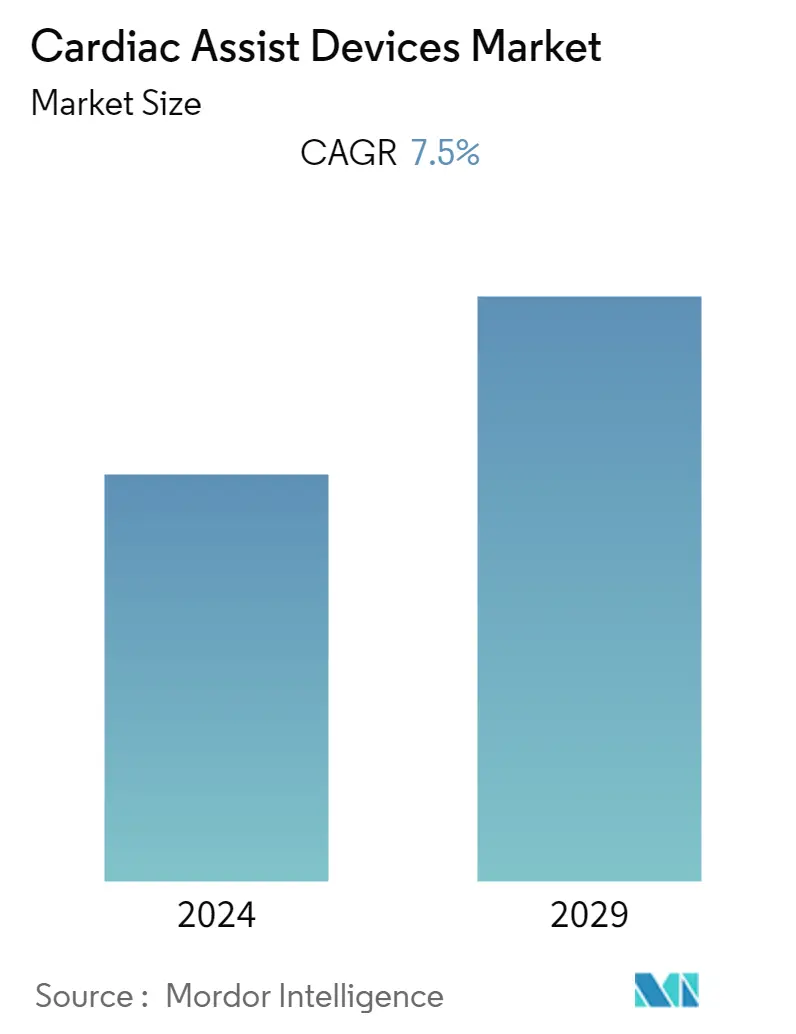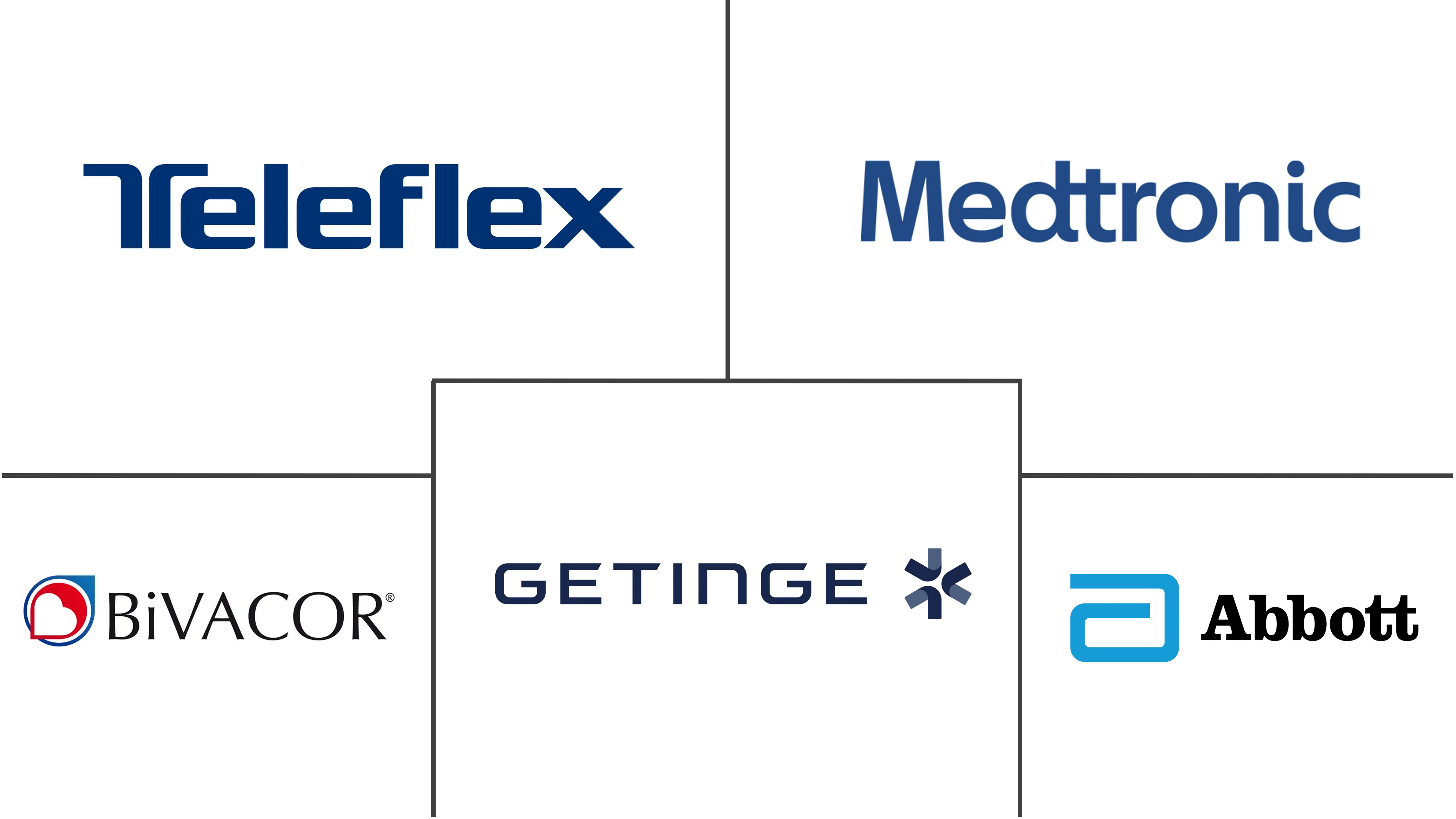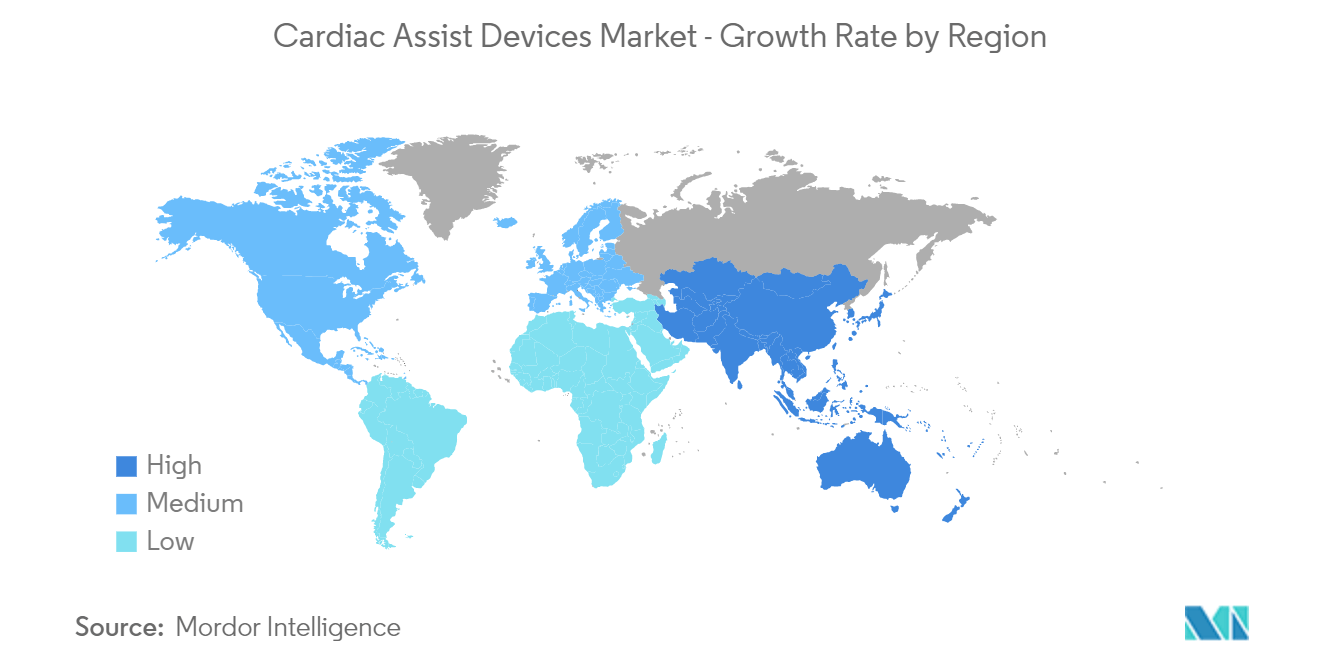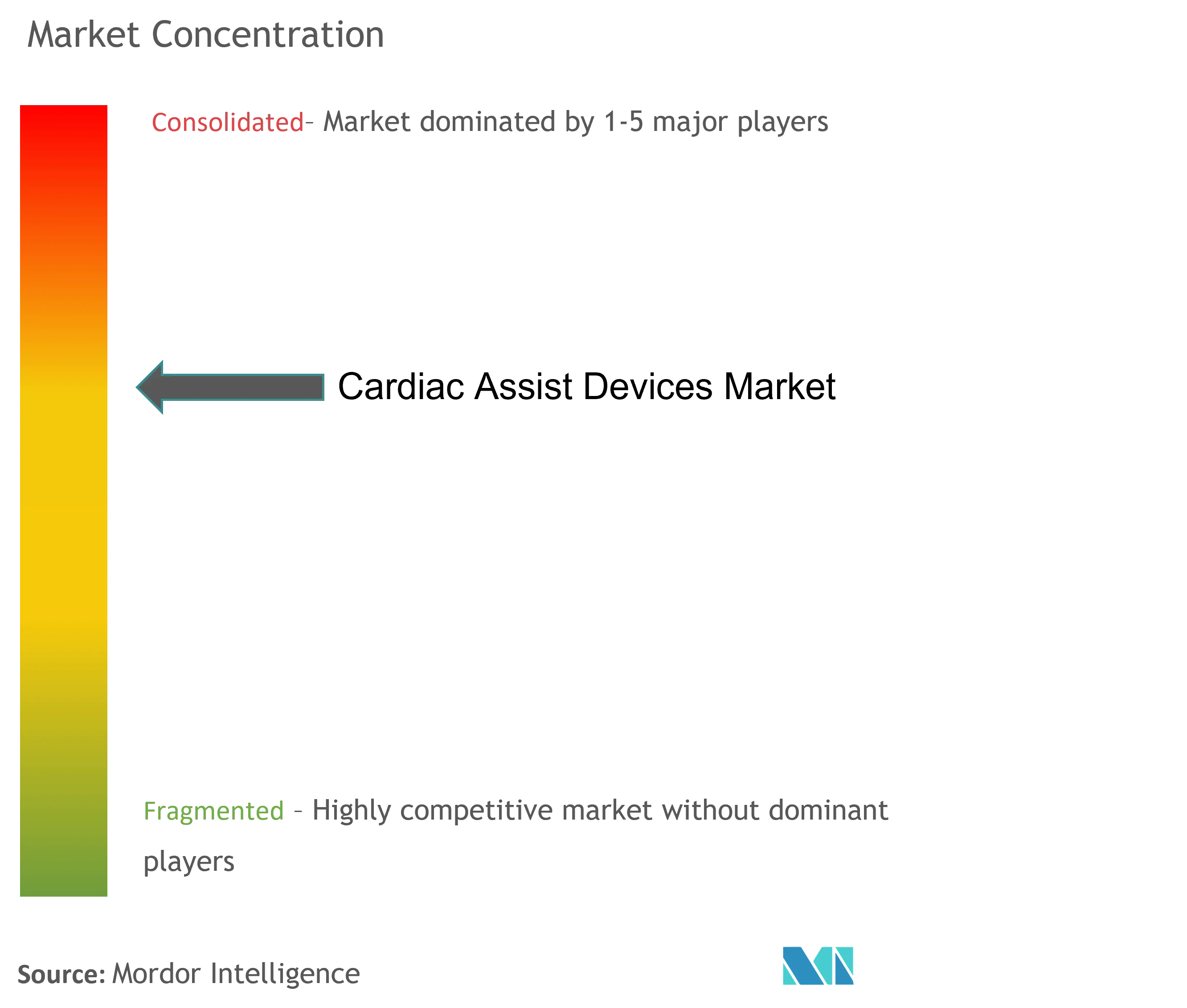Cardiac Assist Devices Market Size

| Study Period | 2021 - 2029 |
| Base Year For Estimation | 2023 |
| CAGR | 7.50 % |
| Fastest Growing Market | Asia Pacific |
| Largest Market | North America |
| Market Concentration | Medium |
Major Players
*Disclaimer: Major Players sorted in no particular order |
Cardiac Assist Devices Market Analysis
The Cardiac Assist Devices Market is expected to register a CAGR of 7.5% during the forecast period.
The COVID-19 pandemic impacted the production of cardiovascular devices. Furthermore, the delay of elective procedures due to COVID-19-related measures adversely affected the cardiac assist devices market, especially in 2020. While some cardiovascular procedures are considered urgent, others were postponed and delayed at the beginning of the global pandemic. Hence, lifestyle changes and medication were temporarily prescribed instead of cardiovascular procedures for some patients. Another factor negatively impacting the market was the reduction in the diagnosis of cardiovascular diseases due to healthcare resources being reserved for COVID-19 patients. Many medical device companies experienced losses in their cardiovascular device businesses due to the pandemic. For example, Medtronic announced a 33% reduction in its cardiac and vascular business sectors in its 2020 quarterly financial results. The continuous strain of the pandemic negatively impacted the growth of the studied market by decreasing product demand. In addition, the market growth is stabilizing in the current scenario after COVID-19 as the worldwide restrictions have eased down and the disease screening services have been resumed. Moreover, increasing initiatives by most organizers to provide solutions to the surging cardiovascular diseases is the prime boosting factor for the market growth by 2027.
The major factor driving the market is the rising global burden of various coronary heart diseases, such as stroke and cardiomyopathy, which cause a global burden of cardiac-related deaths. According to the June 2021 update of the WHO, cardiovascular diseases were the leading cause of death around the world, and about three-quarters of deaths from CVDs were recorded in low- and middle-income countries. Thus, due to the high mortality due to CVDs, the demand for disease diagnostics and monitoring is increasing, which is expected to fuel growth in the cardiac assist devices market.
Furthermore, according to the CDC data updated in July 2022, shows that coronary heart disease is the most common type of heart disease, and approximately 20.1 million adults of age 20 and older have the disease in the United States. This burden of cardiovascular diseases is further expected to increase due to the high prevalence of associated risk factors such as hypertension, obesity, smoking, diabetes, and others, along with a sedentary lifestyle. Thus, the surge in the prevalence of cardiovascular diseases leads to rising demand for the use of cardiac assist devices used in disease monitoring and treatment, thereby driving the growth of the cardiac assist device market over the forecast period.
Moreover, technologies used in the development of cardiology devices have improved significantly over the past decade, and indications for these devices have expanded. This has led to an increasing number of patients being managed with cardiology devices, resulting in exponential therapeutical and monitoring outcomes. Artificial intelligence is one such advancement having a significant positive impact on cardiology with improved capabilities to diagnose certain heart conditions. For instance, in March 2022, Cardiovascular Systems, Inc. (CSI) announced the first-in-human experience with Propel, its first-generation percutaneous ventricular assist device (VAD), offering hemodynamic support for patients undergoing high-risk percutaneous coronary interventions (HR-PCI).
However, the availability of alternative treatments like pacemakers and the risk associated with device implantation are the factors restraining the growth of the cardiovascular devices market.
Cardiac Assist Devices Market Trends
This section covers the major market trends shaping the Cardiac Assist Devices Market according to our research experts:
Total Artificial Heart Segment is Expected to Show Better Growth in the Forecast Period
The total artificial heart (TAH) is a form of mechanical circulatory support in which the patient's native ventricles and valves are explanted and replaced by a pneumatically powered artificial heart. Currently, the TAH is approved for use in end-stage biventricular heart failure as a bridge to heart transplantation.
According to a study published by the British Heart Foundation in January 2022, there were approximately 7.6 million people with heart disease in the United Kingdom, and nearly 160,000 deaths each year. An average of 460 fatalities each day, or one death every three minutes, happen in the United Kingdom due to CVDs. Due to the rising burden of cardiovascular diseases, there is an increasing demand for innovative technologies which can decrease the mortality rates associated with heart failure, thereby increasing the demand for total artificial heart devices during the study period.
The rising research and development studies highlighting the improved survival rates of cardiac patients will increase its adoption, thereby leading to lucrative growth of the market. For instance, according to the study published by The Journal of Heart and Lung Transplantation in March 2021, post-transplant of t-TAH (SynCardia Systems, Tucson, Arizona) survival was 88%, 84%, 79%, and 74% at six months, one year, two years, and five years, respectively, which is significantly high. Hence, technological innovations in the total artificial heart segment are expected to increase the survival rate, thus driving the market segment.
Also, the article published in June 2021 by Wolters Kluwer Health stated that the Carmat Total Artificial Heart (C-TAH) Auto-Mode with built-in pressure sensors effectively produced appropriate physiological responses reflective of changing patients' daily needs and, thus, provided almost physiological heart replacement therapy. Therefore, such technological innovations in the market segment will fuel its growth.
Thus, the rising burden of cardiovascular diseases, along with the increased product launches, is expected to boost the growth of the segment over the forecast period.

North America is Expected to Hold a Significant Share in the Market and Expected to do Same in the Forecast Period
North America is expected to dominate the overall market throughout the forecast period. The presence of high per capita healthcare expenditure, coupled with the rising prevalence of cardiac diseases, is expected to propel the high growth of cardiac assist devices in the North American region. In the North American region, the United States holds the largest share. This is due to the presence of a large population with heart disease. In the United States, cardiovascular diseases and hypertension cases account for a major share of the people that require surgery. For instance, The data updated by Cedars-Sinai in January 2022 shows that coronary artery bypass graft surgery (CABG), also known as coronary artery bypass, or bypass surgery, is the most common type of heart surgery, and more than 300,000 people have successful bypass surgery in the United States each year. In addition, according to the CDC, in the United States, the prevalence of atrial fibrillation is estimated to rise to 12.1 million by the year 2030. This shows a rising burden of cardiovascular diseases in the country, which is expected to demand Cardiac Assist Devices in the United States, driving the market growth.
The major factor driving the market is the rising burden of various coronary heart diseases, such as stroke and cardiomyopathy, which cause a global burden of cardiac-related deaths. As per a report by the United States CDC, statistics updated in 2021, every 40 seconds, an American may have a heart attack. This scenario leads to a higher demand for cardiac-assisted devices for better treatment, which will drive the market in the United States.
Furthermore, supportive awareness initiatives for disease awareness are projected to support the market for cardiovascular devices in North America. For instance, in March 2022, 10 Louisville-area heart failure patients received implanted mechanical pumps through Norton Heart & Vascular Institute's launch and certification of a ventricular assist device (VAD) program. Moreover, in July 2021, CARMAT announced the first implantation of its bioprosthetic artificial heart, Aeson, in the United States within the framework of the Early Feasibility Study (EFS).
Thus, owing to the abovementioned factors, such as the rising prevalence of cardiac diseases and increasing awareness, the North American region is expected to show lucrative growth over the forecast period.

Cardiac Assist Devices Industry Overview
The cardiac assist devices market is moderately competitive. The major players operating in the cardiac assist devices market globally are; Abbott Laboratories, Abiomed Inc., Berlin Heart GmbH, BiVACOR Inc., Braile Biomedica Ltd, Getinge AB, Jarvik Heart Inc., Medtronic PLC, SynCardia Systems, LLC, and Teleflex Incorporated.
Cardiac Assist Devices Market Leaders
-
Abbott Laboratories
-
BiVACOR Inc.
-
Getinge AB
-
Medtronic PLC
-
Teleflex Incorporated
*Disclaimer: Major Players sorted in no particular order

Cardiac Assist Devices Market News
- October 2022: BiVACOR announced a USD 750 thousand grant from the Australian Government through its Medical Research Future Fund (MRFF) and Targeted Translation Research Accelerator (TTRA) program. The funds will be used to improve a patient's experience by specifically focusing on reducing the size and weight of the Total Artificial Heart's (TAH) external controller so that the patient will have a better quality of life at home.
- January 2022: The School of Medical Research and Technology (SMRT) of IIT Kanpur launched Hridyantra, a challenge-based program to develop an advanced artificial heart called a Left Ventricular Assist device (LVAD) for patients with end-stage heart failure.
Cardiac Assist Devices Market Report - Table of Contents
1. INTRODUCTION
- 1.1 Study Assumptions and Market Definition
- 1.2 Scope of the Study
2. RESEARCH METHODOLOGY
3. EXECUTIVE SUMMARY
4. MARKET DYNAMICS
- 4.1 Market Overview
-
4.2 Market Drivers
- 4.2.1 Increasing Prevalence of Cardiovascular Disease along with Surge in Geriatric Population
- 4.2.2 Rise in Awareness Related to Early Screening of Cardiovascular Diseases
- 4.2.3 Technological Advancements Pertaining to Novel Product Development
-
4.3 Market Restraints
- 4.3.1 Availability of Alternative Treatments like Pacemakers
- 4.3.2 Risk Associated with Device Implantation
-
4.4 Porter Five Forces
- 4.4.1 Threat of New Entrants
- 4.4.2 Bargaining Power of Buyers/Consumers
- 4.4.3 Bargaining Power of Suppliers
- 4.4.4 Threat of Substitute Products
- 4.4.5 Intensity of Competitive Rivalry
5. MARKET SEGMENTATION (Market Size by Value - in USD Million)
-
5.1 By Product
- 5.1.1 Intra-aortic Balloon Pump
- 5.1.2 Total Artificial Heart
- 5.1.3 Ventricular Assist Device
- 5.1.3.1 Left Ventricular Assist Device
- 5.1.3.2 Right Ventricular Assist Device
-
5.2 By Modality
- 5.2.1 Transcutaneous
- 5.2.2 Implantable
-
5.3 By End User
- 5.3.1 Hospital Pharmacies
- 5.3.2 Ambulatory Surgical Centres
-
5.4 Geography
- 5.4.1 North America
- 5.4.1.1 United States
- 5.4.1.2 Canada
- 5.4.1.3 Mexico
- 5.4.2 Europe
- 5.4.2.1 Germany
- 5.4.2.2 United Kingdom
- 5.4.2.3 France
- 5.4.2.4 Italy
- 5.4.2.5 Spain
- 5.4.2.6 Rest of Europe
- 5.4.3 Asia-Pacific
- 5.4.3.1 China
- 5.4.3.2 Japan
- 5.4.3.3 India
- 5.4.3.4 Australia
- 5.4.3.5 South Korea
- 5.4.3.6 Rest of Asia-Pacific
- 5.4.4 Middle-East and Africa
- 5.4.4.1 GCC
- 5.4.4.2 South Africa
- 5.4.4.3 Rest of Middle-East and Africa
- 5.4.5 South America
- 5.4.5.1 Brazil
- 5.4.5.2 Argentina
- 5.4.5.3 Rest of South America
6. COMPETITIVE LANDSCAPE
-
6.1 Company Profiles
- 6.1.1 Abbott Laboratories
- 6.1.2 Abiomed Inc.
- 6.1.3 Berlin Heart GmbH
- 6.1.4 BiVACOR Inc.
- 6.1.5 Getinge AB
- 6.1.6 Jarvik Heart Inc.
- 6.1.7 Medtronic PLC
- 6.1.8 Teleflex Incorporated
- 6.1.9 SynCardia Systems, Inc.
- *List Not Exhaustive
7. MARKET OPPORTUNITIES AND FUTURE TRENDS
** Subject To AvailablityCardiac Assist Devices Industry Segmentation
As per the scope of the report, cardiac assist devices are defined as a type of mechanical pump that works along with the heart to improve the pumping efficiency and maintain optimum blood flow throughout the body. The Cardiac Assist Devices Market is segmented by Product (Intra-aortic Balloon Pump, Total Artificial Heart, and Ventricular Assist Device), Modality (Transcutaneous and Implantable), End User (Hospital Pharmacies, and Ambulatory Surgical Centres), and Geography (North America, Europe, Asia-Pacific, Middle East, and Africa, and South America). The market report also covers the estimated market sizes and trends for 17 different countries across major regions globally. The report offers the value (in USD million) for the above segments.
| By Product | Intra-aortic Balloon Pump | |
| Total Artificial Heart | ||
| Ventricular Assist Device | Left Ventricular Assist Device | |
| Right Ventricular Assist Device | ||
| By Modality | Transcutaneous | |
| Implantable | ||
| By End User | Hospital Pharmacies | |
| Ambulatory Surgical Centres | ||
| Geography | North America | United States |
| Canada | ||
| Mexico | ||
| Geography | Europe | Germany |
| United Kingdom | ||
| France | ||
| Italy | ||
| Spain | ||
| Rest of Europe | ||
| Geography | Asia-Pacific | China |
| Japan | ||
| India | ||
| Australia | ||
| South Korea | ||
| Rest of Asia-Pacific | ||
| Geography | Middle-East and Africa | GCC |
| South Africa | ||
| Rest of Middle-East and Africa | ||
| Geography | South America | Brazil |
| Argentina | ||
| Rest of South America |
Cardiac Assist Devices Market Research FAQs
What is the current Cardiac Assist Devices Market size?
The Cardiac Assist Devices Market is projected to register a CAGR of 7.5% during the forecast period (2024-2029)
Who are the key players in Cardiac Assist Devices Market?
Abbott Laboratories, BiVACOR Inc., Getinge AB, Medtronic PLC and Teleflex Incorporated are the major companies operating in the Cardiac Assist Devices Market.
Which is the fastest growing region in Cardiac Assist Devices Market?
Asia Pacific is estimated to grow at the highest CAGR over the forecast period (2024-2029).
Which region has the biggest share in Cardiac Assist Devices Market?
In 2024, the North America accounts for the largest market share in Cardiac Assist Devices Market.
What years does this Cardiac Assist Devices Market cover?
The report covers the Cardiac Assist Devices Market historical market size for years: 2021, 2022 and 2023. The report also forecasts the Cardiac Assist Devices Market size for years: 2024, 2025, 2026, 2027, 2028 and 2029.
Cardiac Assist Devices Industry Report
Statistics for the 2024 Cardiac Assist Devices market share, size and revenue growth rate, created by Mordor Intelligence™ Industry Reports. Cardiac Assist Devices analysis includes a market forecast outlook to 2029 and historical overview. Get a sample of this industry analysis as a free report PDF download.



